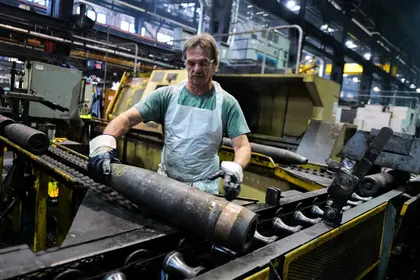A lack of explosives – itself caused by downsizing at the end of the Cold War – is to blame for the EU’s inability to provide Ukraine with the one million artillery shells it has pledged by March 2024, The Economist reported.
Few munition factories remained on the continent following the end of the Cold War in the 1990s, where factories either scaled back their operations or closed down altogether, leaving only a handful capable of manufacturing NATO-standard explosives.
JOIN US ON TELEGRAM
Follow our coverage of the war on the @Kyivpost_official.
Among those are one unnamed major TNT producer in northern Poland, Chemring Nobel in Norway, and France’s Eurenco, which has facilities in Sweden, where the publication said the latter two are operating at full capacity, with Chemring Nobel’s order “chock-full until 2030” after Russia’s 2022 invasion.
In November 2023, Kyiv Post reported that Bulgaria remained one of the major producers of Soviet-standard shells the West has supplied to Ukraine, which has been a target of frequent Russian sabotage.
Europe has attempted to remedy the shell shortage by allocating €500 million ($542 million) to its defense sector to ramp up production and churn out two million shells a year by the end of 2025 through the Act in Support of Ammunition Production (ASAP) initiative.
For comparison, Estonian defense officials estimated in February 2023 that Europe’s shell production was 300,000 annually, as reported by CNN – a far cry from the one million shells Russia was reportedly able to secure from North Korea on top of its domestic production.

Moldova Residents Caught in the Middle of Gas Fight
Under the ASAP initiative are €124 million ($134 million) “project portfolio budget” allocated towards explosive production and €248 million ($269 million) towards the powder production – propellant for the shells.
However, even with the extra funds, some experts argued the lack of skilled workers and supply chain constraints, among other issues, remain hurdles the bloc has to surmount.
While it is possible to refurbish older factories to expand production, Tim Lawrenson of the International Institute for Strategic Studies, a think-tank, told the publication that restarting old plants will take time due to the need to retool and refurbish facilities.
Meanwhile, an unnamed source told the publication that starting a new factory would take three to seven years, which would not be able to remedy the shortage Ukraine is facing at present.
Johann Höcherl, a professor at the Bundeswehr University in Munich, told The Economist that few graduates are also incentivized to work with explosives after their graduation, while the existing engineers are getting old and retiring.
In addition, procuring nitric acid, a chemical necessary to produce explosives such as TNT, has been difficult in recent years as most of its production went towards fertilizer production. The chemical’s production is also energy-intensive, which means it’s subject to the fluctuation in global energy prices apparent after Russia’s invasion of Ukraine.
Cotton pulp, a core component in making nitrocellulose, which is used in explosives and propellants, is mostly imported from China, which created another supply chain issue for the EU.
Christian Mölling, a political scientist working with the German Council on Foreign Relations think tank, also told The Economist that safety and environmental regulations could hamper Europe’s plan to expand explosive production.
One potential solution would be to source explosives from abroad, from countries such as India and Japan. However, unnamed experts, as cited by The Economist, worried that overseas explosives could be of inferior quality and potentially damage equipment.
In November 2023, Russian troops reportedly had to adjust the range of North Korean shells to compensate for the potentially inferior quality despite bearing the same Soviet standard.
You can also highlight the text and press Ctrl + Enter










